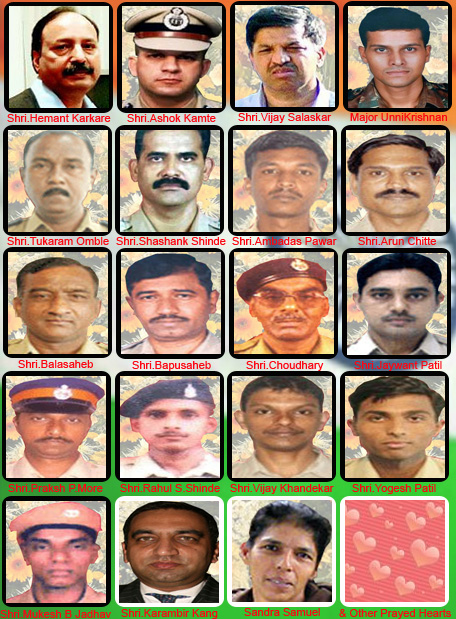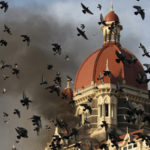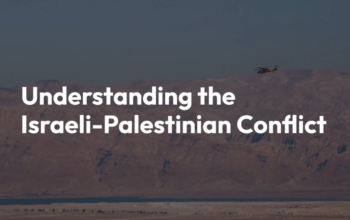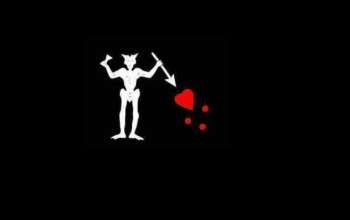It’s been two years since we got attacked by some A$$HOLES. On this day, let’s stand up and salute all our brave heros who lost their lives to safeguard our safety and integrity, and also extend our condolences to the families and friends of those who lost their lives in the worst ever terror assault in the history of India.
You have any idea about how much our heros are getting paid? No more than RS 5600-13800 !! I felt really ashame of myself earning some lakhs per year but really worthless to my country.
( Image courtesy : http://www.brinjy.com/26_11.asp?cat= )
One Good news is
NO TERRORIST ATTACKS SINCE 26/11
Here is a quick update on our Security before and after
Post- 26/11, the Government’s response to the coastal security imperatives has been multi-dimensional and prompt. A suitable command structure for maritime security has been firmed up; 4 Joint Operation Centres have been set up and placed under the Naval Commander-in-Chiefs; a Sagar Prahari Bal has been constituted and Standard Operating Procedures (SOPs) for coastal security have been finalized in respect of all coastal States/UTs.
With the full implementation of the first phase of the Coastal Security Scheme by March 2011, States/Union Territories will be better equipped in terms of Coastal Police Stations (73), Boats (204), Vehicles (153), two-wheelers (312) and manpower/equipment including computers.
The second phase of the Coastal Security Scheme has also been finalized and approved with an outlay of Rs.1579.91 crore. This will further supplement the States/UTs by providing more Police Stations (131), Boats (180), Large Vessels, (10), Jetties (60) and RIBs (35). The Scheme will also provide support for equipment, computer systems, vehicles, two-wheelers etc. A uniform system for registration of all boats has been put in place and is under operationalization. Action is also being taken for issuance of ID cards to all fishermen. There is increased emphasis on technology usage and the process of installation of transponders on vessels to ensure identification and tracking has been initiated. Radar chains are also being strengthened. The Registrar General of India has also undertaken a census of the entire coastal population and is finalizing arrangements for issuance of MNICs in this area. The security of ports including minor ports and the training of security personnel is also receiving adequate priority. All decisions/initiatives for strengthening/revamping coastal security are being monitored at multiple levels including a National Committee chaired by the Cabinet Secretary.
Multi-dimensional initiatives have been taken and are under rapid implementation and the coastlines are decidedly more secure today than before. Much more needs to be done and many initiatives are still under implementation. The reduction in the vulnerabilities along the coastline and the strengthening of the security set up responsible for coastal security would be steady and sustained.
Following is the statement of the Prime Minister, Dr. Manmohan Singh on remembrance day of Mumbai attack:
“Two years ago this day, Mumbai was subjected to a brutal terrorist attack that claimed the lives of hundreds of innocent people. The nation joins the bereaved families in remembering and mourning those who perished in this barbaric attack. On this day of remembrance, we salute the courage, unity and resolve of ordinary Mumbaikars and the brave and selfless actions of our men in uniform during the attack. It is this spirit and strength of character of the Indian people that will defeat such forces that seek to threaten our social fabric and way of life. We will never succumb to the designs of our enemies. We pledge to redouble our efforts to bring the perpetrators of this crime against humanity to justice.”
Here is a short video from PBO on Two Years After Mumbai Attacks
As the second anniversary of the bloody, three-day siege in Mumbai, India, nears, Ray Suarez gets an update from journalist Sebastian Rotella of ProPublica on new information that has emerged about the perpetrators.
If you can’t load this video, here is the link
Transcript
JUDY WOODRUFF: Next tonight: As we near the second anniversary of the terror attacks in Mumbai, India, new information emerges about the perpetrators. Ray Suarez has the story.
RAY SUAREZ: The bloody siege of Mumbai lasted almost three days — 166 people were killed, including six Americans. This was the scene outside the Taj Mahal Palace, a luxury hotel popular with Western tourists and wealthy Indians.
Inside, four militants from the Pakistan-based Lashkar-e-Taiba went room to room gunning down their victims. At the same time, four other targets in the city were attacked: the Oberoi Hotel, the Leopold Cafe, the central train station, where closed-circuit cameras captured these chilling images of a calm-looking gunman, and the city’s Chabad House, a community center for ultra-Orthodox Jews.
In the two years since the attack, we have learned more about the group behind it and the meticulous planning that went into it. The focus has been on the so-called project manager of the plot, a Pakistani known as Sajid Mir.
SEBASTIAN ROTELLA, ProPublica: He is a very mysterious figure.
RAY SUAREZ: Journalist Sebastian Rotella spent five months investigating the Mumbai attacks and Mir’s role in them. His reports, funded by ProPublica, an online investigative news outlet, appeared in The Washington Post earlier this week.
SEBASTIAN ROTELLA: He first pops up in cases back in 2001, training a mix of Americans, Frenchmen, Australians, Britons, and then deploying them on various missions around the world.
RAY SUAREZ: So little is known about Mir, his real age can’t even be determined. But authorities do know that, during the siege of Mumbai, Mir was overseeing almost every detail over the phone from a base in Pakistan, calling his teams of 10 gunmen on the ground to tell them what to do, whom to kill, when to kill them, and how to die themselves.
In one tape, after a gunman has handed his phone to a Mexican tourist at the Chabad House, Norma Rabinovich, Mir is heard, in accented English, telling the woman to propose a prisoner swap.
NORMA RABINOVICH, Mexican Tourist: I was talking to the consulate just a few seconds ago. And they are making the phone call. They said to leave the line free.
SAJID MIR, gunman: Don’t worry, Norma. Just sit back and relax and don’t worry and just wait for them to contact, OK?
NORMA RABINOVICH: Yes, sir.
SAJID MIR: And save your energy for good days.
RAY SUAREZ: Hours later, Mir ordered his gunmen to kill Rabinovich and another hostage. He listened over the phone as the gunman executed the women.
(GUNSHOT)
RAY SUAREZ: Did this mission, this mission, this attack represent something new for Lashkar-e-Taiba?
SEBASTIAN ROTELLA: It did, certainly, both in the scope and the targeting. It wasn’t the first time they had targeted the West. But this was a dramatic escalation. It combined, in a very al-Qaida style, a mix of targets. So, you strike India in its heart, you know, Mumbai, its economic and cultural heart, but you very specifically go after American, European, Jewish targets.
RAY SUAREZ: To prepare for the attack, Sajid Mir recruited an unlikely source to go on five separate scouting missions to Mumbai.
Daood Gilani was in his mid-40s when he traveled to a Lashkar training camp in Pakistan. Born in Washington, D.C., to a Pakistani father and a socialite American mother, Gilani had a reputation as a ladies man and a checkered past. He was arrested in the mid-’90s for dealing heroin in New York, later becoming an informant for the Drug Enforcement Agency. He changed his name to David Coleman Headley in order to travel with greater ease.
SEBASTIAN ROTELLA: He was the perfect spy in a lot of ways and the perfect operative for the people he ends up having relationships with, that is, drug traffickers, Pakistani intelligence, American — the DEA, because here’s a guy, really, a man of many worlds.
He’s born in the United States, has a U.S. passport, doesn’t look particularly Pakistani. But he grows up in Pakistan, yet he comes back to the United States and really slides into a very kind of decadent world of drug-dealing and partying. And he somehow manages in a very — like a chameleon, to combine all those worlds.
RAY SUAREZ: Here is this guy with this background that practically screams, “Look at me,” and it seems like they missed him. How?
SEBASTIAN ROTELLA: I think that law enforcement and intelligence have a tendency to put people in boxes. And they perhaps had a view of what an Islamic extremist is. And he, for a series of reasons, didn’t conform to that.
There’s a series of warnings starting back in October 2001, even before he begins training with Lashkar, from girlfriends, wives, associates of the family. There are half-a-dozen warnings between late 2001 and just after the Mumbai attacks to U.S. authorities.
RAY SUAREZ: Yet, Headley wasn’t arrested until last October, nearly a year after the Mumbai attacks. At the time, he was plotting another attack with Sajid Mir, a similar-style commando raid on the offices of the Danish newspaper that had published cartoon depictions of the Prophet Mohammed.
Headley had cased the offices and taken video, again presenting himself as an American businessman. And just as signs about Headley’s involvement were ignored, so too were signals that the group Lashkar-e-Taiba was preparing a raid on the scale of the Mumbai attacks.
SEBASTIAN ROTELLA: There seems to be a systematic sense that Lashkar is not seen as a danger. You get the feeling that the investigators just weren’t seeing it as a threat to the United States.
RAY SUAREZ: After Mumbai, Indian officials accused Pakistan of significant ties to Lashkar. Here’s how the Indian home secretary, G.K. Pillai, described Pakistan’s involvement: “It wasn’t just a peripheral role. They were literally controlling and coordinating it from the beginning until the end.”
Counterterrorism officials argue over how close the link between Lashkar-e-Taiba and Pakistani intelligence really is. Lashkar was originally set up to fight on Pakistan’s behalf in Kashmir, territory claimed by both India and Pakistan.
Sebastian Rotella says there’s plenty of evidence of some sort of connection.
SEBASTIAN ROTELLA: The debate among Western and Indian anti-terror officials is, what is the extent of that involvement? Are we talking about a few isolated individuals within the intelligence service who go rogue or exceed their grasp or who have some awareness, but are playing a half-active, half-passive role?
Or, as other voices would argue, can an attack of this magnitude, of this sophistication, two years in the plotting by a group that is so close to the security forces, really be carried out without at least the knowledge of people higher up?
RAY SUAREZ: Pakistan says it’s gotten more aggressive with Lashkar. Last year, it arrested the group’s military chief and six others. But that trial has stalled.
In June, an Indian court convicted the only surviving Mumbai gunman, this man, captured on videotape from the train station. David Coleman Headley pled guilty last year to helping organize the Mumbai attacks and targeting the Danish newspaper. Because he is cooperating with investigators, he has yet to be sentenced.
And in one sign of the success of the Mumbai operation, and the new influence of Lashkar-e-Taiba, al-Qaida has recently warned of Mumbai-style attacks in Europe.
SEBASTIAN ROTELLA: What’s interesting and scary about it, I think, is that it’s — this idea of Mumbai-style attacks shows that some of these Lashkar approaches and techniques are coming into play, both individuals and approaches to attacks. And it has American and European security forces very concerned.
RAY SUAREZ: Earlier this month, President Obama became the first visiting head of state to stay at the Taj Hotel since the attack. He also met with victims.
U.S. PRESIDENT BARACK OBAMA: We will never forget the awful images of 26/11, including the flames from this hotel that lit up the night sky.
We will never forget how the world, including the American people, watched and grieved with all of India. But the resolve and the resilience of the Indian people during those attacks stood in stark contrast to the savagery of the terrorists.
RAY SUAREZ: The man who plotted that savagery, Sajid Mir, remains at large in Pakistan. Authorities believe he is planning other attacks.
Related Posts
Hi there! I’m Sethu, your go-to guy for all things tech, travel, internet, movies, and business tips. I love sharing insights and stories that make life more interesting. Let’s explore the world together, one article at a time!











